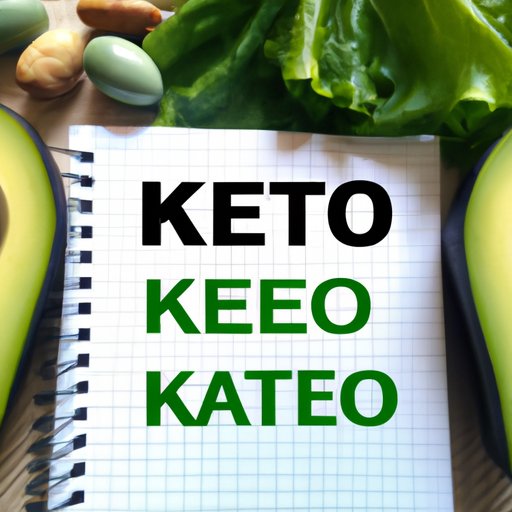
Introduction
The keto diet, short for ketogenic diet, has become increasingly popular in recent years for its potential benefits. This low-carb, high-fat diet has been linked to weight loss, improved energy levels, and even a decreased risk of certain diseases. However, before jumping into this lifestyle change, it’s important to understand what it consists of and how to properly follow it.
The Ultimate Guide to Understanding the Keto Diet: What it Consists Of
The keto diet is a high-fat, moderate-protein, and low-carb diet that is designed to put your body into a state of ketosis. When in ketosis, your body burns fat for fuel instead of carbohydrates, leading to weight loss and other benefits. It’s important to note that ketosis is different from ketoacidosis, which is a dangerous condition that can occur in people with uncontrolled diabetes.
When following a keto diet, your macronutrient breakdown typically consists of 70-80% fat, 20-25% protein, and 5-10% carbs. This drastically differs from the Standard American Diet, which typically consists of 50% carbs, 15-20% protein, and 30% fat.
Foods that are allowed on a keto diet include meat, fish, eggs, low-carb vegetables, nuts and seeds, healthy fats (olive oil, avocado, coconut oil), and dairy products in moderation. Foods to avoid include starchy vegetables, grains, sugar, and high-carb fruits.
Breaking Down the Keto Diet: A Comprehensive Look at its Components
Now that we know what a keto diet consists of, let’s break down each component in more detail.
Fat
Fat plays a major role in a keto diet, as it is the main source of fuel for the body in the absence of carbohydrates. Fat is broken down into ketones during ketosis, which the body uses for energy. Good sources of healthy fats for a keto diet include avocados, nuts, seeds, olive oil, and coconut oil.
Protein
Protein is important for building and repairing tissues in the body, but too much protein can kick you out of ketosis. When on a keto diet, it’s important to consume a moderate amount of protein. Good sources of protein for a keto diet include meat, fish, eggs, and tofu.
Carbs
Carbohydrates are limited on a keto diet, as they can disrupt the body’s production of ketones. When consuming carbs on a keto diet, it’s important to stick to low-carb vegetables and limit your intake of fruits. Some good low-carb vegetables include spinach, broccoli, cauliflower, and zucchini.
A Beginner’s Guide to the Keto Diet
If you’re new to the keto diet, it can seem overwhelming at first. Here are some tips and tricks to help you get started:
Start Slowly
If you’re used to consuming a lot of carbs, it can be difficult to switch to a low-carb diet overnight. Start by slowly reducing your carb intake and increasing your healthy fat intake over time.
Meal Planning
Meal planning is key when following a keto diet, as it can be difficult to find keto-friendly foods when eating out. Plan your meals ahead of time and stock up on keto-friendly ingredients.
Stay Hydrated
When in ketosis, the body tends to lose more water than usual, which can lead to dehydration. Make sure to drink plenty of water throughout the day to stay hydrated.
Some common mistakes to avoid when starting the keto diet include not tracking your macros, not increasing your fat intake enough, and not consuming enough fiber.
Going Keto: How to Follow a High-Fat, Low-Carb Diet for Weight Loss
The keto diet has been shown to be effective for weight loss, mainly due to the fact that it puts the body into a state of ketosis. When in ketosis, the body burns fat for fuel instead of carbohydrates, leading to weight loss.
It’s important to track your macros when following a keto diet, as consuming too many carbs or protein can kick you out of ketosis. It’s also important to supplement with electrolytes, as the body loses more water than usual when in ketosis.
Some recommended supplements for those following a keto diet include magnesium, potassium, and electrolyte mixes.
The Science Behind a Keto Diet: Understanding the Role of Macros and Ketones
When following a keto diet, the body enters a state of ketosis, which is when it burns fat for fuel instead of carbohydrates. During ketosis, the body produces ketones, which are molecules that the body can use for energy.
The role of macros (fat, protein, and carbs) in a keto diet is to keep the body in a state of ketosis. Consuming too many carbs or protein can kick you out of ketosis, which can negate the benefits of the diet.
Conclusion
In conclusion, the keto diet can be an effective way to lose weight and improve your overall health. By properly understanding the components of the diet and tracking your macros, you can ensure that you are staying in a state of ketosis and receiving the maximum benefits of the diet.
Overall, it’s important to do your research and consult with a healthcare professional before starting any new diet or lifestyle change. With the right tools and knowledge, the keto diet can be a great way to improve your health and reach your weight loss goals.




